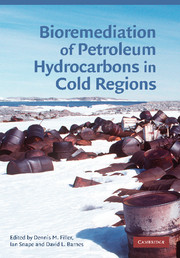Book contents
- Frontmatter
- Contents
- List of contributors
- Preface
- Glossary
- 1 Contamination, regulation, and remediation: an introduction to bioremediation of petroleum hydrocarbons in cold regions
- 2 Freezing and frozen soils
- 3 Movement of petroleum through freezing and frozen soils
- 4 Hydrocarbon-degrading bacteria in contaminated cold soils
- 5 Temperature effects on biodegradation of petroleum contaminants in cold soils
- 6 Analytical methods for petroleum in cold region soils
- 7 Treatability studies: microcosms, mesocosms, and field trials
- 8 Nutrient requirements for bioremediation
- 9 Landfarming
- 10 Thermally enhanced bioremediation and integrated systems
- 11 Emerging technologies
- References
- Index
7 - Treatability studies: microcosms, mesocosms, and field trials
Published online by Cambridge University Press: 22 August 2009
- Frontmatter
- Contents
- List of contributors
- Preface
- Glossary
- 1 Contamination, regulation, and remediation: an introduction to bioremediation of petroleum hydrocarbons in cold regions
- 2 Freezing and frozen soils
- 3 Movement of petroleum through freezing and frozen soils
- 4 Hydrocarbon-degrading bacteria in contaminated cold soils
- 5 Temperature effects on biodegradation of petroleum contaminants in cold soils
- 6 Analytical methods for petroleum in cold region soils
- 7 Treatability studies: microcosms, mesocosms, and field trials
- 8 Nutrient requirements for bioremediation
- 9 Landfarming
- 10 Thermally enhanced bioremediation and integrated systems
- 11 Emerging technologies
- References
- Index
Summary
Introduction
Treatability assessments are used to identify limitations to the rate or endpoint of bioremediation for a specific soil-contaminant combination. For treatability studies, the degradation pathways for the contaminant are generally known (see Chapter 4, Section 4.2.1), but the limitations in a particular soil or at a specific site are less well understood. The tremendous utility of treatability studies is in evaluating practical treatment regimes prior to full-scale implementation. The goal is to demonstrate practicability, optimize treatment design, and provide information for project planning. Sometimes this is an essential proving step for clients or regulators because choice of treatment depends primarily on urgency of remediation and cost. The cost-time relationship for different treatment types is illustrated in Chapter 1, Figure 1.1. The ability to predict the rate of bioremediation progress for a treatment scheme is particularly important in cold regions where costs are higher and treatment times are longer than in temperate regions.
In an effort to understand and improve the bioremediation process in cold regions, researchers have used treatability experiments to:
identify the presence or absence of microbial activity for a particular contaminant or group of contaminants;
determine optimum requirements, such as temperature, nutrients, oxygen, and water, for bacteria and fungi to metabolize contaminants in the soil regime;
examine the effects that natural cycles, such as freezing-thawing and wetting-drying, have on microbial activity and degradation rate;
estimate achievable endpoints;
predict and compare treatment times and costs.
Treatability studies can involve in vitro microcosms with individual bacterial species or consortia from the soil incubated in liquid or slurry media, mesocosm studies with soils and natural microfauna, or field trials.
- Type
- Chapter
- Information
- Bioremediation of Petroleum Hydrocarbons in Cold Regions , pp. 125 - 153Publisher: Cambridge University PressPrint publication year: 2008
- 4
- Cited by



